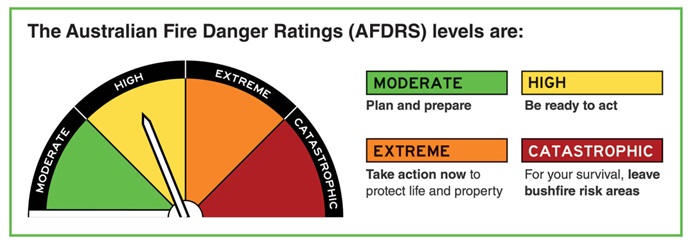 Bushfire is a fact of life in New South Wales. The state is one of the most susceptible areas to bushfire in the world.
Bushfire is a fact of life in New South Wales. The state is one of the most susceptible areas to bushfire in the world.
Bushfires can occur at any time but are most common and severe during from October to March. This is known as the bushfire season. Weather patterns suggest that NSW is becoming warmer and drier and that bushfires may become more frequent and intense.
National Parks and Wildlife Service (NPWS) carries out hazard reduction burns and other activities to reduce the risk of bushfire in national parks. However, the threat of bushfire cannot be eliminated and fire operations in parks can pose a risk for park visitors and neighbours.
Fire danger ratings
Fire danger ratings give you an indication of the consequences of a fire, if one was to start. The higher the fire danger rating, the more dangerous the conditions. You can use the fire danger ratings as a trigger for actions in your bush fire survival plan, such as leaving bushfire risk areas on days of Extreme or Catastrophic fire danger.

To find out more about the new system, please visit the Australian Fire Danger Rating System website.
To check the fire danger ratings in New South Wales, please visit the NSW Rural Fire Service website.
Total fire bans
During the bush fire danger period, the Commissioner of the NSW Rural Fire Service may declare a total fire ban for particular fire weather areas within NSW, or state-wide.
During a total fire ban (minimum 24-hour period) no fire may be lit in the open. This means:
- All campfire and solid fuel (wood, heat beads, charcoal, briquettes, hexamite) and liquid fuel (petroleum, oil, methylated spirits, kerosene) barbecues and stoves are prohibited.
- Gas barbeques installed by NPWS may be used for cooking, as long as it is under the direct control of a responsible adult, is clear of combustible material within two metres at any time it is operating, and there is an immediate and continuous supply of water available.
- Visitor-owned gas and electric barbecues and cookers are generally prohibited. There may be exceptions if you contact the local park office in advance for permission. Gas and electric cookers are permitted within a caravan or 3-sided enclosed annexe of a caravan.
- Landholders who have received a hazard reduction permit from the NSW Rural Fire Service to undertake prescribed burning are not allowed to light fires during total fire bans.
The NPWS may also declare a park fire ban or even close particular reserves where the potential risk to visitors from fire is high.
To find out where and when a total fire ban has been declared, please visit the NSW Rural Fire Service website.
Be prepared
If you live in a bushfire-prone area or are planning to visit a national park, make sure that you prepare for the fire season by recognising the bushfire risk and knowing how to respond.
The NSW Rural Fire Service provides specific information on current fire events, warnings and alerts and information on how to prepare yourself and protect your home in the bushfire season.
The NSW NPWS website provides information on fire safety, fire bans and park closures. Before visiting a park, it is important that you check for current fire alerts and notifications of park fire bans, total fire bans and park closures.

